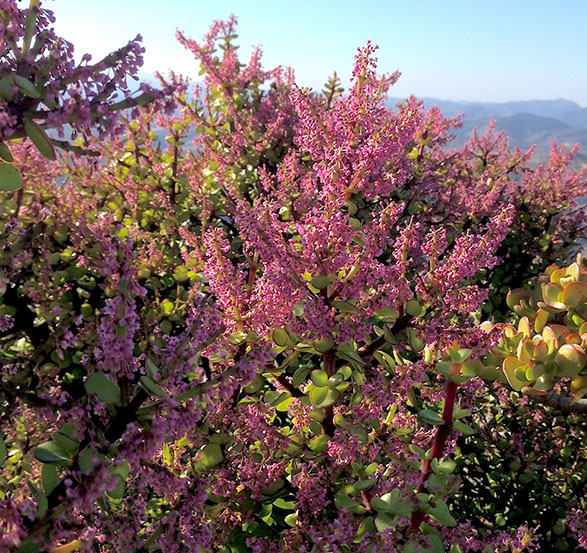Arizona landscapes are known for their bold use of succulents and desert-adapted plants. While cactus and agave often take center stage, other drought-tolerant species add variety, texture, and greenery to desert gardens. One plant gaining popularity for both residential and commercial designs is Elephant Food (Portulacaria afra). With its lush foliage, versatility, and resilience, this South African native offers year-round appeal in Arizona’s challenging climate.
Elephant Food, sometimes called Elephant Bush or Spekboom, is a perennial succulent shrub native to South Africa. In the wild, it can grow up to 10 feet tall, but in Arizona landscapes, it usually stays between 3 and 6 feet, depending on how it’s pruned and maintained.
The plant is characterized by small, round, glossy green leaves growing on reddish-brown stems. Its dense foliage resembles jade plant (Crassula ovata), but Elephant Food grows faster and adapts more readily to desert conditions. In summer, mature plants sometimes produce clusters of small pink flowers that attract pollinators.
As its name suggests, Elephant Food is actually eaten by elephants in its native habitat. In fact, it has gained international attention for its environmental benefits, Portulacaria afra is known to absorb large amounts of carbon dioxide, making it an eco-friendly landscape choice.
Elephant Food thrives in hot, dry conditions, making it well-suited for Arizona’s desert climate. Once established, it requires minimal water and can survive extended dry periods.
Unlike many desert perennials that go dormant, Elephant Food maintains its greenery year-round. Its lush, full foliage softens the often-harsh textures of desert plants and gravel landscapes.
This plant is highly adaptable. It can be shaped into a hedge, pruned into a bonsai-style specimen, or allowed to sprawl naturally. Its compact leaves and branching stems make it equally suitable for formal designs and casual, naturalistic gardens.
When in bloom, Elephant Food’s nectar-rich flowers attract bees and butterflies. Even when not flowering, its dense growth provides habitat and shelter for small desert creatures.
Elephant Food grows beautifully in pots and raised planters, making it perfect for patios, courtyards, and poolside landscapes. Its tidy growth and drought tolerance make it low-maintenance for container gardens.
Elephant Food’s versatility makes it valuable in many Arizona landscape designs:
Accent Plant: Its lush foliage stands out against the muted tones of gravel and rock.
Hedges and Borders: With pruning, it forms a low hedge or border plant along walkways or patios.
Erosion Control: On slopes, its roots help stabilize soil while its foliage adds greenery.
Containers and Raised Beds: Works well in pots, providing greenery where other plants might struggle.
Companion Plantings: Complements agaves, aloes, and desert perennials by adding softness and contrast.
Sunlight: Prefers full sun but benefits from some afternoon shade in the hottest months, especially when young. Too much shade, however, can cause leggy growth.
Soil: Needs well-draining soil. Sandy or gravelly soil is ideal. In containers, use cactus or succulent potting mix.
Watering: Water deeply but infrequently. Overwatering is the most common cause of problems. Once established, it thrives with very little irrigation.
Pruning: Can be pruned to maintain shape or size. It responds well to trimming, making it easy to use in hedges or bonsai.
Frost Protection: Elephant Food is frost-sensitive and may be damaged below 30°F. In colder parts of Arizona, grow it in containers that can be moved indoors during winter or cover outdoor specimens on frosty nights.
Fertilization: Occasional feeding with a balanced, diluted fertilizer during the growing season promotes vigorous growth.
Cold Sensitivity: While tough against heat and drought, it’s not as cold-hardy as some desert shrubs. Strategic placement near walls or structures can help protect it.
Growth Management: Without pruning, it can become sprawling. Regular trimming keeps it tidy and encourages fuller growth.
Flowering: Though attractive, flowers are not guaranteed every year. Expect blooms mainly on older, established plants.
Elephant Food is a standout plant for Arizona landscaping, bringing lush greenery, resilience, and versatility to desert gardens. Whether used as a hedge, accent, or container specimen, it thrives with minimal water and care while offering year-round beauty. Its environmental benefits, pollinator-friendly flowers, and easy maintenance make it a smart choice for homeowners looking to blend sustainability with style.
For those seeking a plant that softens desert landscapes without sacrificing hardiness, Elephant Food is a practical and eye-catching addition to Arizona yards.


We’re Now Copper Ridge Landscaping & Design! ELM Landscaping & Design is rebranding to Copper Ridge Landscaping & Design. Same trusted team and ownership. Same licensed, bonded, and insured company, proudly serving you for over 25 years. Thank you for growing with us!